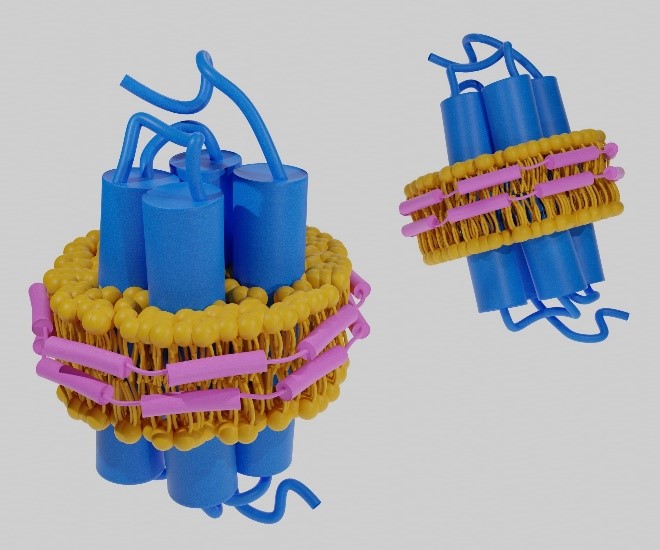Membrane Proteins & Nanodiscs
Please see our all Membrane Proteins & Nanodiscs
Nanodiscs Related Products
Membrane proteins represent a substantial portion of all known drug targets, making them crucial for understanding disease mechanisms and developing targeted therapies. Despite their significance, their structural and functional studies have been hindered by the delicate lipid bilayer that surrounds them in cell membranes. Isolating and stabilizing membrane proteins outside their natural environment often leads to structural distortions and loss of function, limiting our understanding of their roles in cellular processes.
Traditional methods for studying membrane proteins, such as detergent solubilization, may disrupt their native structure, leading to inaccurate results. Additionally, obtaining sufficient quantities of membrane proteins for research purposes has been a laborious and resource-intensive process.
What Are Nanodiscs?
Nanodiscs represent a breakthrough technology that overcomes these challenges and revolutionizes membrane protein research. Nanodiscs are discoidal lipid bilayers stabilized by encircling membrane scaffold proteins (MSPs) or synthetic polymers. Typically, 8-16 nm in diameter, these nanoscale patches of membrane provide a stable environment for embedding membrane proteins, allowing researchers to study their structure, function, and interactions in a controlled manner.

The typical MSP nanodisc consists of three primary components:
- Lipids: Nanodiscs are composed of lipids, which are the same building blocks found in biological membranes. Commonly used lipids include phospholipids, which have a hydrophilic (water-loving) head group and hydrophobic (water-repelling) fatty acid tails.
- Membrane scaffold protein (MSP): The MSP acts as a belt around the lipids, holding them together and stabilizing the nanodisc. MSPs allow the reconstitution of membrane proteins into a soluble form, facilitating their structural and functional studies in solution. They are amphipathic molecules comprising an N-terminal α-helical domain that interacts with the lipid bilayer and a C-terminal soluble domain responsible for solubility.
- Target membrane protein: The nanodisc is designed to encapsulate a specific membrane protein of interest. The protein can be incorporated into the nanodisc during its formation, allowing it to reside within the lipid bilayer.
Creative Biostructure has developed a diverse range of MSPs, both with and without His-tags, capable of assembling into tailor-made nanodiscs of varying sizes. Moreover, these constructs can be customized to accommodate an assortment of affinity tags, such as Cys, FLAG, and more, located at the sequence's terminal end. Furthermore, specific protease cleavage sites can be strategically incorporated into this region of the sequence, ensuring the effortless removal of these affinity tags after purification.
| Cat No. | Product Name | Species | Tag | Scaffold Diameter |
| MSP-1001 | Human MSP1D1 lyophilized protein with a His-tag | Human | His | 9-11 nm |
| MSP-1002 | Human MSP1D1 dH5 lyophilized protein with a His-tag | Human | His | 7-8 nm |
| MSP-1003 | Human MSP1E3D1 lyophilized protein with a His-tag | Human | His | 12-14 nm |
| Browse our complete list of MSP products | ||||
In addition, based on our Mempro™ Nanodisc technology, we have developed assembled nanodiscs with assembled recombinant membrane proteins, as well as pre-assembled nanodiscs composed of different MSPs (MSP1D1, MSP1E3D1, and MSP2N2) and phospholipids (POPC, DMPC, and DMPG).
| Cat No. | Product Name | Species | Tag | Scaffold Diameter |
| NADSC-003H | Nanodisc Canine CD20/MS4A1 Protein | Canine | His | / |
| CBS-dMSP1D1-DMPC-1 | Mempro™ Pre-assembled Nanodisc Human MSP1D1 dH5-His with DMPC | Human | His | 7-9 nm |
| CBS-MSP1E3D1-DMPC-1 | Mempro™ Pre-assembled Nanodisc Human MSP1E3D1-His with DMPC | Human | His | 12-14 nm |
| Browse our complete list of assembled nanodiscs | ||||
Advantages of Nanodiscs
- Preservation of native environment: Nanodiscs preserve the native lipid environment around the membrane protein, allowing researchers to study their structure and function in a biologically relevant context.
- Enhanced stability: By embedding membrane proteins within the lipid bilayer, Nanodiscs confer enhanced stability, preventing denaturation and maintaining the protein's integrity during experimentation.
- Detergent-free: Unlike traditional detergent-based methods, Nanodiscs eliminate the need for harsh detergents that can disrupt protein structure and compromise experimental results.
- Versatility: Nanodiscs are compatible with various analytical techniques, including nuclear magnetic resonance (NMR), X-ray crystallography, and cryo-electron microscopy (cryo-EM), enabling a comprehensive understanding of membrane protein behavior.
Applications of Membrane Protein in Nanodiscs
- Structural studies (X-ray crystallography, cryo-EM, and solution-state NMR)
- Drug discovery: Study the interactions between membrane proteins and potential drug candidates, aiding in drug discovery and development processes.
- Functional assays: Study membrane proteins activities and interactions with other molecules.
- Biophysical studies: Reveal information about protein dynamics, conformational changes, and protein-protein/protein-lipid/protein-ligand/protein-additive interactions.
- Vaccine development: Nanodiscs can be used to present these proteins in their native conformation, enhancing the immune response and potentially leading to more effective vaccines.
- Bioengineering and synthetic biology: By incorporating engineered membrane proteins into nanodiscs, researchers can build functional nanodevices for various applications, such as biosensing and drug delivery.
- Membrane protein stability and folding studies: Nanodiscs provide a suitable environment for investigating the folding and stability of membrane proteins.
Creative Biostructure specializes in nanodisc preparation, membrane protein reconstitution, nanodisc characterization, nanodisc computational research and nanodisc application. We also offer other highly customized nanodisc products and services. Please feel free to contact us to discuss your project.
